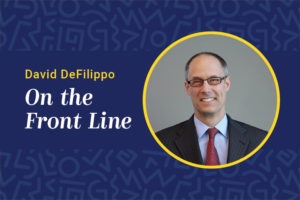
With continual questions about HR’s value, now is the time to focus on its strategy, structure and talent.
by David DeFilippo
February 8, 2016
In the current fast-paced, results-oriented business environment, outcomes and impact are the priority. All facets of the human resources function have a critical role to play. As the function evolves, CEOs, academics and industry experts are debating its relevance, efficacy and future role. This leads to issues and opportunities in which HR can reinvent itself to create greater short- and long-term organizational value.
Research and articles dating from Fast Company’s 2005 “Why We Hate HR” to more recent 2015 Harvard Business Review articles “Why We Love to Hate HR” and “People Before Strategy: The New Role for the CHRO,” questions are being raised about the effectiveness of the modern day HR function. Deloitte University Press’ “Global Human Capital Trends 2015” cites three central elements to “reinventing HR”: structure, talent analytics and data. Further, in their 2010 book “One Page Talent Management,” authors Marc Effron and Miriam Ort underscore HR’s ineffectiveness because of the overcomplicated processes and underutilization of academic research and behavioral science to underpin and form HR practices.
Concern over these issues is still valid given the typical cost of a firm’s human capital and the workforce requirements for the knowledge-worker generation. “In today’s business environment, workforce performance is more important than ever, which makes the effectiveness of HR practices a top priority,” said Annie McKee, a senior fellow at the University of Pennsylvania. “The risk associated with not optimizing an organizations people practices too high.”
By taking a step back and refocusing on the truth that HR exists to improve an organization’s performance and potential, these issues can be addressed through strategy, structure and talent alignment.
The HR field can trace its historical evolution back to the post-World War II era when talent shortages were a reality, and practices such as on-the-job development, assignment rotations and succession were born. According to “Why We Love to Hate HR,” this focus led to 90 percent of internal positions being filled internally because of the focus on workforce planning requirements coupled with the dedication to preparation and development for the next role. Starting in the 1970s with the first instance of a slowing economy, companies began to invest less in these systematic HR practices created to develop employees and leaders.
This pattern continued through the 1980s with some relief during the 1990s dot-com boom, only to be damaged once again when the dot-com bubble burst, and even more so during the financial crisis that began in 2008. With this backdrop and the reality that most current business leaders progressed to their roles during this declining period of HR as a lead function, it is not surprising there is something amiss yet little clarity how to address it.
Strategy, Structure and Talent
The situation becomes more confounding when HR and learning leaders attempt to balance seemingly separate and competing interests. First, consider the board of directors whose fiduciary responsibility it is to watch over current needs and prepare the organization for its next generation. Next, there are the CEO and business leaders focused on organizational growth and optimization whether by organic means, acquisitions, or virtue of reinvention. Then there are the employees who are interested in meaningful work, career progression and being appreciated, among other things.Finally, there is the HR team whose role and desire is to support and add value to these three constituencies.
This misalignment of concerns combined with a combination of the ups and downs of the labor market in the face of shorter business cycles and growing demands leads to the following three issues.
1. Strategy: Business goals and HR priorities are misaligned. This seems obvious, but how often do we find out that what solution the business wanted from HR is not what we thought we were delivering? This issue stems from the level of involvement the HR team has in the strategy development and refinement process. For example, to meet revenue and growth goals, a firm decides to redesign its client acquisition and business development process. These strategies are central to the business’ revenue goals, analyst expectations and board of director commitments, so it is definitely an important plan to get right. Is this plan delivered to the HR leader and team once it is formulated, or is it conceived as an equal partnership with that team? This question gives rise to translation risk, meaning the strategy development process is done in isolation and handed off to HR, so it is no wonder there is a probability of mismatch.
To address this danger, let’s change this all too common paradigm and have HR leaders and teams run the strategy development process in partnership with an initiative sponsor and the executive team. Who better to facilitate an integrated strategic planning process than the leader who touches a firm’s human capital processes and the associated dimensions around planning, acquiring, developing, rewarding and engaging talent? Because it is HR’s practice to manage these interrelated elements, it is not a stretch to expand those connections to broader business issues such as client satisfaction scores, sales territory design and the business development pipeline. In this way, instead of the oft-cited line from HR practitioners asking for “a seat at the table,” HR is setting the table so the team can dine together.
2. Structure: HR teams are not structured to perform.With strategic alignment addressed, the next issue to tackle is how HR implements the strategic plan. Organizations go through cycles of centralizing, decentralizing or running a hybrid or federated model. These dramatic shifts are merely panaceas for the central problem that HR needs to be structured as an integrated part of the business, aligned to the aforementioned strategic plan and plugged into day-to-day operations so it can nimbly address issues.
As explained in Harvard Business Review’s “People Before Strategy,” Ram Charan, Dominic Barton and Dennis Carey’s G3 Model, which creates a triad between the CEO, CFO and CHRO, provides a good first version of the opportunity for alignment among the strategic, financial and human capital agendas. If leaders build on that approach, they advance the opportunity for structural alignment; version 2.0 of that approach includes the senior most operations, client and marketing executives to mitigate a three-sided solution when a five- or six-dimensional one is most appropriate. Practically, the integration of these disciplines and diverse perspectives can be accomplished via a consistent governance process in combination with rotating facilitation by one of these executives. This is one approach to address the alignment of HR and leadership.
Building further, there is the HR team itself. Charan’s suggested outline and approach of dividing HR into HR Leadership and Organization, or HR-LO, and HR Administration, or HR-A, makes great sense with respect to the stratification of HR’s work and talent. Aligning the longer-term tasks such as succession planning and leadership development to one part of the HR team, and segmenting the day-to-day operations composed of benefits administration and employee relations to another area provides the differentiation that creates conflict for senior executives and HR practitioners alike.
Simply put, by acknowledging and structuring around the short- vs. long-term focus, HR can use each area’s strength. One group remains focused on day-to-day operations and execution, while another is focused on the organization’s future requirements. One refinement to Charan’s HR-LO and HR-A model is to not divide HR-A and HR-LO among the CEO and CFO but to keep them integrated, with the CHRO reporting to the CEO to foster HR functional alignment.
3. Talent: Ensure that HR has the right skill sets and experiences. With the strategy aligned with structure, the last piece to arrange is talent. Matthew Breitfelder and Daisy Waderman Dowling discussed this in their 2008 Harvard Business Review article titled “Why Did We Ever Get into HR?” Both graduated from Harvard Business School and pursued HR careers because of the impact they could make, which was contrary to the norm among their classmates. This raises the question about the perception that our best and brightest talent have not traditionally entered the HR field, but instead ended up there through various career twists and turns. Further underscored by HR.com videos like “When I Grow Up (I Want to Be in HR)” that lightheartedly poke fun at the choice to become an HR practitioner, with this messaging, it is not surprising that people question HR’s perceived value.
There are several ways to address the talent situation. First, make HR a coveted career path, assignment or rotation that leads to upward trajectory for high-potential employees. Organizations signaling that being in an HR role is selective and leads to upward movement will create positive momentum.
Next, ensure or plan for HR practitioners to rotate through a line-management role. Regardless of the industry, an early stage HR practitioner will learn a tremendous amount about leadership and management by having operational responsibility for a business function and team. The ancillary benefit of this line-management experience for HR staff is the increase in street credibility among operational peers.
Lastly, master the discipline of HR. As Effron and Ort discuss throughout “One Page Talent Management,” the science of behavioral, industrial and organizational psychology all inform HR practices. It is paramount that HR professionals are fluent in those subjects.
“Given the pace and complexity of business today, we need HR talent that can predict the firm’s workforce needs and build simple processes for ensuring the organization always has a human capital advantage,” said Steve Arneson, leadership expert and author. “That takes people who truly understand the marketplace/talent dynamic, have the analytic horsepower to make a business case, and the courage and confidence to influence senior leaders.”
Given the questions being raised about HR’s currency and value, the time is now to focus on HR’s strategy, structure and talent in ways that are organizationally aligned, hands-on and contextually meaningful to one’s organization. As HR leaders set the table, arrange the courses and then share the various dishes with their business partners, the dinner conversation and questions about HR’s relevance will subside.
Dave DeFilippo is the chief learning officer for Suffolk Construction. Comment below, or email editor@CLOmedia.com.




